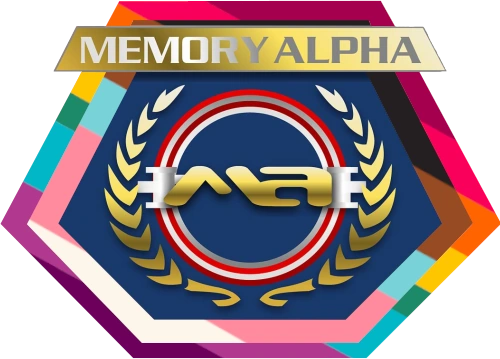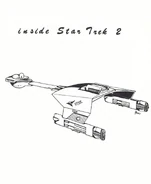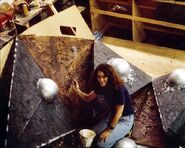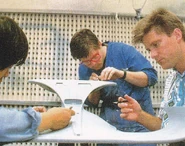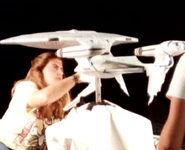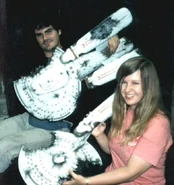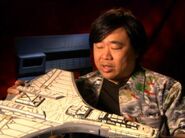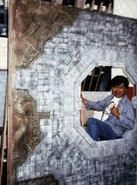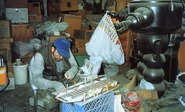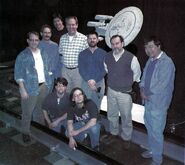Greg Jein (31 October 1945 – 22 May 2022; age 76) was a multiple Academy Award nominated science fiction model-maker and artist whose work includes studio models, props, and other artwork, such as landscape miniatures, that have appeared throughout the Star Trek franchise. He spent much of his professional career as an independent contractor operating his own model shop, "Gregory Jein Inc."
Jein was honored by SkyBox International with an individual card entry, no. 26, in their 1993 specialty Star Trek: The Next Generation - Behind the Scenes trading card set.
Phase II, The Motion Picture and "Encounter at Farpoint"[]
Greg Jein, an avid lifelong Star Trek: The Original Series fan, traces his professional connections to Star Trek as far back as the last quarter of 1977, when Magicam subcontracted him to construct the first Star Trek: Phase II variant of the D7-class studio model. [7](X)
Though his build was eventually passed over for a larger version, he was asked by Douglas Trumbull nearly two years later to construct several miniatures for Spock's spacewalk inside V'ger for what had become Star Trek: The Motion Picture. Initially thought to be a short assignment, Trumbull again approached Jein in late July 1979, three weeks into his initial assignment, when the realization struck that no work had been done yet on the interior V'ger studio models. Officially brought in by Entertainment Effects Group, since that company's mother company Future General Corporation was responsible for filming the interior footage of V'ger, Jein was given a mere three-four weeks to construct the various interior sections of V'ger. Greg Jein had to mobilize a large group of friends and acquaintances to get the work done in time. "We called people all over town. There were probably close to twenty or thirty of us working on it, on and off. At least four weekends we didn't go home at all. When it finally came out, we were still two or three days late.", he recalled. Bringing along a team that included novices Lisa Morton, Don Pennington, and Bill George of later Industrial Light & Magic (ILM) fame as pupils, they were still working on one end of the models, while filming had started on the other end. (Cinefex, issue 2, pp. 42-45)
In 1987, ILM had him work as pattern or master lead modeler on the construction of the two and six-foot studio models of the USS Enterprise-D for the pilot episode "Encounter at Farpoint" of the new Star Trek: The Next Generation television series, reuniting him with his former pupil George. Apart from these, Jein was also largely responsible for the builds of the space vessel lifeform model and the Farpoint station maquette.
Forming Gregory Jein, Inc.[]
When Greg Jein was brought in for the second time on the Motion Picture he needed to cover legal liabilities for the staff he had brought with him, and to this end he formed on 31 July 1979 his own company, Gregory Jein, Inc., which went dormant after he was finished on the film and a subsequent project, continuing to work on personal title as he had done before. [8] Upon completion of the work on "Encounter at Farpoint", he left ILM, revitalized his company with his workshop now located at Glencoe Avenue in Marina Del Rey, California and started working as an independent contractor company for the Star Trek franchise. (Cinefantastique, Vol 23 #2/3, p. 95) The build of the D'Kora-class studio model for the series fourth episode, "The Last Outpost", was the company's first Next Generation commission. Among his most notable achievements during this time were the four-foot USS Enterprise-D, which he built for later seasons of The Next Generation, and the recreated USS Enterprise and Deep Space Station K-7 models built for DS9: "Trials and Tribble-ations", Jein receiving his only Star Trek Emmy Award nomination for his visual effects work on that episode in 1997.
Gregory Jein, Inc. was the primary supplier of studio models for the The Next Generations series during its entire run and produced the vast majority of the models for that series. Only during the second half of 1989 was the company not available to the television franchise, as the services of the company were exclusively reserved first by Associates & Ferren for Star Trek V: The Final Frontier (with newcomer John Eaves, with whom Jein struck up a close and enduring personal friendship), and subsequently by Paramount Pictures for the production of The Hunt for Red October (with Ron Gress and Alan McFarland), made responsible for the construction of the various submarine studio models featured therein. [9] For both productions the company was subcontracted by the respective lead model making companies, Jein and his co-workers being lumped together under one credit only, "Gregory Jein, Inc.", for the first one (according to Eaves, Jein was less than cordially treated during the production [10]) and as Boss Film Studios in the latter case. During that period the slack was taken up by Starlight Effects and Tony Meininger. For The Final Frontier, Jein and his company also constructed, besides filming models, a range of hand-held props, the most notable being the more militaristic looking 2293 Type 2 phaser, designed by William Shatner and Nilo Rodis-Jamero. (The Making of the Trek Films, 3rd ed., p. 126) The only two other model builders called in on other occasions during those years, Science Fiction Modelmaking Associates and Jein's former pupil Bill George, were contracted to ease the workload on Gregory Jein, Inc. when demands for specific episodes were particularly tasking for the company. It was hot on the heels of the company's tenure for Red October, that the four-foot Enterprise-D model was constructed, late December 1989, during the holiday season. [11](X)
The models Jein and his company built for The Next Generation were predominantly shot at VFX company Image G, and just like his Original Series predecessor Richard C. Datin, Jr. had done for his builds, Jein could frequently be found on the stages of Image G, supervising the correct handling of the models, thereby serving as an impromptu model rigger/operator, as several behind-the-scenes stills and footage can attest to, among others in the special feature Stardate Revisited: The Origin of Star Trek - The Next Generation.
During The Next Generation years, Jein and his company were also called in to provide Star Trek VI: The Undiscovered Country with an additional range of hand-held props as well as replacing a number of Type 2 phaser he had done for the previous movie outing, but had been stolen by then. (The Making of the Trek Films, 3rd ed., p. 126) Aside from this, the company also constructed in the early 1990s, Star Trek-based display models for the Planet Hollywood restaurant-franchise, [12] most notably that of the four-foot USS Enterprise-D, using the actual molds of the filming model (with the first one turning up in the New York City restaurant, which was the first to open [13](X)), and, out of his own volition, reference models to fill in historical gaps in official Star Trek lore for representation in Michael Okuda's 1993 official reference book, Star Trek Chronology, with whom Jein struck up an enduring friendship. [14](X)
Even though they had created the landscape maquette for Benjamin Sisko's vision sequence in the pilot episode "Emissary" (Movie Magic (TV series), Season 1, Episode 11), Gregory Jein, Inc. was superseded as primary studio model vendor for Star Trek: Deep Space Nine and Star Trek: Voyager by Meininger's Brazil-Fabrication & Design, though his company stepped in as Brazil's contributions started to wane after the fourth season of Deep Space Nine, resuming the provision of services for the franchise on an occasional basis, the "Trials and Tribble-ations" models, and the half-scale USS Excelsior model for "Flashback", the most notable ones. Another contribution was the crash site maquette of the USS Olympia in "The Sound of Her Voice". [15](X) Yet, by this time Jein had to let go of most of his staff, and relied on freelancing sub-contractors to help him out when time was once again of the essence such as in the case of "Trials and Tribble-ations" for which he sub-contracted lighting expert Larry Albright and veteran mold plasterer Gunnar Ferdinandsen.
The company is no longer in existence, dissolved by Jein, [16] and has no further officially recorded credits to its name after the pilot episode of Deep Space Nine. Jein continued to ply his trade as an individual independent contractor on personal title, just as he started out. In 1998, for example, he worked on personal title for the model shop of Blue Sky/VIFX on the production of Star Trek: Insurrection.
While Jein's company was involved with televised Star Trek, it became tradition to take a Polaroid of each and every finished model which was hung on a "wall-of-fame" in his modelshop. (Star Trek: Official Guide 4 - Mechanics, p. 145) Occasionally, Jein also commissioned the Los Angeles-based RGB Color Lab photography studio to take professional photos of his builds for potential publicity purposes, and several of these were used as such when they became featured in reference works, like the Star Trek: The Next Generation - The Continuing Mission and Star Trek: Official Guide 4 - Mechanics books. A multitude of original negatives and color transparencies of these were later sold as the at US$1,000 estimated Lot #89319 at the below-mentioned Heritage auction for US$17,000 ($21,250 with buyer's premium). [17]
Staff[]
While operating Gregory Jein, Inc., his staff during the company's Star Trek years at one time or another included, among others:
- Staff
- Larry Albright (1996, subcontractor)
- Eduardo Batres (1987-1990) [18]
- Bill Church (1992, Model Maker [19])
- John Eaves (1989-1991)
- Gunnar Ferdinandsen (1996, subcontractor [20] [21](X))
- Bill George (1979)
- Mike Harsh
- Jason Kaufman (1991-1994, 1998)
- Bruce MacRae (1989-1993)
- David Merriman, Jr. (1989-1990, subcontractor)
- Lisa Morton (1979, 1987)
- Don Pennington (1979)
- Warren Riggs (1988-1989 [22] [23](X))
- Scott Schneider (1987-1988, 1991)
- Richard Slifka
- Greg Stuhl
- Dana White (1989-1990)
- Lou Zutavern (1987-1997 [24])
As was the case with several of the staff he brought with him on The Motion Picture, Jein's company served as a breeding ground for future visual effects talents. Riggs, Stuhl, and Schneider started out in the motion picture industry at Jein's, whereas Eaves and Kaufman were given the opportunity to further hone their budding talents.
Star Trek model work[]
Models credited in full or in part to Jein and/or his company include the following,
(This list is currently incomplete.)
- Star Trek films
- Star Trek: Phase II
- D7-class model – first three-foot variant (unused)
- Star Trek: The Motion Picture
- V'ger – interior sections
- Star Trek V: The Final Frontier
- Refit Constitution-class shuttlebay – both sizes
- Galileo-type shuttlecraft – both sizes
- Pioneer 10
- Props
- Star Trek VI: The Undiscovered Country
- Props
- Star Trek: Insurrection
- Son'a collector – Study model
- Son'a shuttle – Study model
- Star Trek: Phase II
- Star Trek: The Next Generation
- TNG Season 1
- Batris freighter
- Constellation-class – fullfledged filming model
- space module
- D'deridex-class – original model
- D'Kora-class – both models
- Farpoint Station maquette
- Galaxy-class – both six, and two-foot models
- Space vessel lifeform
- TNG Season 3
- Ambassador-class
- D'deridex-class model – second model
- Galaxy-class – four-foot model, and its derivatives
- Gomtuu
- TNG Season 4
- Freedom-class
- McKinley Station
- Nebula-class – full-fledged filming model
- Niagara-class
- Vor'cha-class
- TNG Season 5
- Apollo-class
- Oberth-class – damaged SS Vico
- K't'inga-class – half-scaled model
- Lysian sentry pod
- TNG Season 6
- Dyson Sphere – Interior and exterior maquettes
- Remmler Array
- Sydney-class
- TNG Season 7
- Galaxy-class – anti-future four-foot model variant modifications
- Maquis fighter/raider
- Negh'Var warship
- TNG Season 1
- Star Trek: Deep Space Nine
- DS9 Season 1
- Benjamin Sisko's vision landscape maquette
- Bajoran vessel
- DS9 Season 3
- DS9 Season 4
- IKS Drovana – battle-damaged Vor'cha-class
- DS9 Season 5
- Constitution-class – half-scaled model
- D7-class – originally scaled model
- Deep Space Station K-7 – second model
- IKS B'Moth – battle-damaged K't'inga-class
- DS9 Season 6
- USS Olympia wreck – crash site maquette
- DS9 Season 1
- Star Trek: Voyager
- VOY Season 3
- Excelsior-class – second half-scaled model
- VOY Season 3
- Reference models (for representation in Star Trek Chronology/Star Trek Encyclopedia)
- Bonaventure (C1-21) – a copy of which used onscreen as a display model, with a second copy used as museum display piece
- Daedalus-class – a copy of which used onscreen as a display model, with a second copy used as museum display piece
- DY-100-class with booster rockets – also screen-used display model
- Galaxy-class – four-foot display models for the Planet Hollywood restaurant franchise
- Romulan-Earth War-era Romulan starship
- SS Valiant
The bulk of the models Jein and his company had build for live-action Star Trek was auctioned off by the franchise in Christie's high profile 2006 40 Years of Star Trek: The Collection auction in which they took center stage, being perceived by "Trekkies" everywhere as the "starring" showstoppers. Acutely aware of that circumstance, Christie's actually invited Jein to write the foreword of their auction catalog. And indeed, the Jein models did very well at the auction in effect, all of them selling well beyond their auction estimates.
Commercial availability[]
At one point in time some of Jein's work was commercially available to the public. On 22 May 1997, Viacom, the parent company of Paramount Pictures, opened the Viacom Entertainment Store in Chicago, an attempt to emulate the merchandise store formula like the Disney Store and Warner Bros. Studio Store. Part of its merchandise was a limited production run of twelve each of Jein models for Star Trek, cast by Jein's company from the same molds as the original studio versions. The models chosen were the four-foot Galaxy-class, the D'deridex-class, the second (smaller) Excelsior-class, the Vor'cha-class, the D7-class, and the "Trials and Tribble-ations" version of the Constitution-class. They were sold in the US$5,000-$10,000 price range apiece, and came with certificates of authenticity, signed by Jein (the Constitution-class certificate also signed by original designer Matt Jefferies). These commercial models were, however, more crudely detailed and sported no internal lighting. The store was not a success and closed down in 1998. That was the only time Jein originals were commercially available. [25](X) Pieces that by that time went unsold ended up in Planet Hollywood restaurants or the shop at the Las Vegas Star Trek: The Experience attraction [26] – for whose "The History of the Future Museum" exhibition Jein had, incidentally, constructed additional copies of the Daedalus-class, and Bonaventure (C1-21) models.
Inside Star Trek, issue 2
TNG: "Encounter at Farpoint"
TNG: "Encounter at Farpoint"
Star Trek V: The Final Frontier
TNG: "The Defector"
TNG: "The Best of Both Worlds, Part II"
TNG: "All Good Things..."
Cameo[]
Jein provided photographs of himself in a baseball jersey to be used on a prop piece of artwork: Benjamin Sisko's baseball card depicting Buck Bokai in. Keone Young was later chosen to perform the role in the Star Trek: Deep Space Nine episode "If Wishes Were Horses". Many DS9 crew members were astonished by the physical similarity between the two men, although the producers maintained that this was a coincidence, and that they had simply cast the performer with the best acting ability. (Star Trek: Deep Space Nine Companion, p. 54) The card itself had been on display in the "The History of the Future Museum" exhibition at the Star Trek: The Experience attraction. [27](X)
Being a fan[]
As a fan, he provided art work in 1968 for the fanzine Inside Star Trek, among others the cover of issue two, continuing to do so for the fanzine T-Negative and the book Avon's 8, a fan-produced anthology of the British science fiction series Blake's 7, of which Jein was also a big fan. [28]
An influential piece of fan work was, when he wrote up an analysis of starship registries for the April 1973 issue of T-Negative, "The Case of Jonathan Doe Starship", in which he matched known and assumed names of starships to the, otherwise unrelated list of registry numbers seen in Commodore Stone's office in the Original Series first season episode "Court Martial". He also established that the Constitution-class designation had become in vogue, at least behind-the-scenes, replacing the somewhat nondescript Starship-class designation, though actual canon references only became apparent years later in the live-action franchise. [29] This list of starships with registry numbers became popular among fans, and eventually FASA role playing game incorporated it into their sourcebooks. Michael Okuda, a fellow Original Series fan and who became aware of Jein's article when both men were working on The Undiscovered Country, adopted the list as a well-meant courtesy from one fan to another, for the official Chronology/Encyclopedia of 1993/4, and for which Jein, incidentally, had built the above mentioned reference models. Many of the registries became canon with the remastering of the Original Series in 2006, when Okuda, serving as visual effects supervisor for the upgrade, married, where applicable, most of Jein's numbers to their respective ships. One of his registry numbers, that of the USS Defiant (NCC-1764), had already appeared previously on-screen in the 2005 two-part season four episode, "In a Mirror, Darkly" of Star Trek: Enterprise.
Aside from this, Greg Jein was always an avid movie memorabilia collector, and it was through his attendances at conventions in the 1970s, and subsequent acquaintances, that model makers like Lisa Morton, Don Pennington an Bill George got their first shots in the motion picture industry, as the first has attested to. (Sense of Scale) An avid live-long fan of The Original Series, Jein owned, aside from all the series' script treatment versions, [30] several props and studio models from that series, including the original Galileo shuttle model, he was gifted upon its discovery in the studio in 1987, as well as the Botany Bay model, both of which he had loaned out for display to the last "Equicon Science Fiction Convention(X)" of 1-3 April 1988, held in Los Angeles [31](X), and subsequently to the NASM's 1992-1993 Star Trek Smithsonian Exhibit and its 1993-1994 follow-up exhibition at the Hayden Planetarium, New York City. [32] Jein also provided several screen-used Original Series captain's chair's buttons, given to him by Original Series Special Effects Supervisor Jim Rugg, for the recreation of the partial Original Series bridge, featured in the Next Generation's sixth season episode "Relics". (Cinefantastique, Vol. 24, issue 3/4, p. 26)
In 2007, Jein served as technical adviser on James Cawley's fan-made internet series Star Trek: New Voyages (since rechristened Phase II) episode "World Enough and Time", which featured, Jeffery Quinn, George Takei, Grace Lee Whitney, Majel Barrett Roddenberry, and John Carrigan.
Career outside Star Trek[]
Other projects he worked for included among others the motion picture productions, not few of them considered science-fiction classics, Dark Star (1974), the science fantasy porn spoof Flesh Gordon (1974, serving alongside industry newcomer Joe Viskocil, who also was to work on The Motion Picture), Close Encounters of the Third Kind (1977, working as sub-contractor for Douglas Trumbull's Future General Corporation), and 1941 (1979), which was the movie directly preceding his (second) participation in The Motion Picture. Directly after The Motion Picture, he revisited Close Encounters, still as "Gregory Jein, Inc.", for its 1980 "Special Edition", bringing along several of the staffers he had with him while working on the former for additional studio model work, after which his company went dormant until The Next Generation. Again as an individual contractor, he has subsequently worked on Fukkatsu no hi (1980), War of the Worlds, The Blob (both 1988 and by then as his revived company), and after Berman-era Star Trek, The Scorpion King (2002), The Chronicles of Riddick (2004, uncredited model shop supervisor but alongside Steve Burg, Daren Dochterman and makeup artists Glenn Hetrick and The Motion Picture's Ve Neill) [33], Serenity (2005), Avatar (2009), The Adventures of Tintin (2011), John Carter (2012), and Oblivion (2013). Another project he worked on was The Adventures of Buckaroo Banzai Across The 8th Dimension (1984, 2002 with several Trek alumni including Denise Okuda, Christopher Lloyd, Mark Stetson, and Robert Ito, among others). One of Jein's last recorded credits as model maker concerned the one he received for the acclaimed science fiction movie Interstellar (2014, again alongside Burg, and featured in one of the specials on its Blu-ray Disc release).
Television movies and series, he worked upon included among others, V (1983) and V (The Final Battle). Around the time Paramount Television developed Deep Space Nine they had concurrently another science fiction television series in development, called The Osiris Chronicles, and conceived in order to capitalize to the fullest on the renewed interest in science fiction at the time. For the pilot episode "The Warlord: Battle for the Galaxy", it was Jein's company that created the studio models, based on the designs of Jein's former pupil John Eaves. [34] [35] The series however, was not picked up and the pilot episode remained the only one produced. The fact that Jein and his company were slated to become the primary model vendor for this series, might explain why he was not retained for Deep Space Nine, or that he was awarded the commission as compensation for losing the Star Trek account. Some of Jein's builds for the series later turned up in various 2008 It's A Wrap! sale and auctions as lots 7528(X), 7748(X) and 9615(X), alongside the otherwise exclusively Star Trek lots.
Jein was nominated for the Best Visual Effects Academy Award in 1977 and 1979 for his work on Close Encounters of the Third Kind and 1941, respectively. Jein also received no less than three consecutive nominations for the ADG Excellence in Production Design Awards, for Avatar (2010), Alice in Wonderland (2011), The Adventures of Tintin (2012), winning the first one. He was also nominated for an Emmy for his effects work on the HBO mini-series, Angels in America.
As one of the most revered professionals among his peers in the trade, Greg Jein became prominently featured in the 2011 documentary Sense of Scale, in which several model makers discuss their craft, with Jein discussing, among others, his contributions to The Motion Picture and "Trials and Tribble-ations", and which also features Ron Gress, Pat McClung, Gene Rizzardi, as well as his former co-workers/apprentices Lisa Morton, Scott Schneider and Bruce MacRae.
Retirement and death[]
As the craft of physical model making had all but died out by 2015 as a result of the advent of CGI, the widely interspersed films Alice Through the Looking Glass (2016) and Mulan (2020) became the last two Hollywood productions on which Jein was known to have worked in a professional capacity, after which he seemed to have recused himself from the industry.
On 28 June 2022 it was reported by several former colleagues of Jein, that he died on 22 May 2022 at the age of 76. [36] Jein succumbed to cardiac arrest after a long history of health issues that included a battle with diabetes. A family spokeswoman explained that the family had decided to keep his death a private affair for a month before going public. [37]
"The Greg Jein Collection" auction(s)[]

Catalog cover of the October 2023 Heritage auction
Jein's next-of-kin decided to liquidate his massive collection of Hollywood memorabilia by putting it up for auction. Two auctions were held in October 2023; the extensive 14-15 October "The Greg Jein Collection Hollywood Platinum Signature® Auction #7278" held by Heritage Auctions, and the far more modest[1] 7-10 October "The Greg Jein Collection" one held by Studio Auctions, a much smaller auction house. The Heritage auction was by far the most substantial one, as it not only featured production assets Jein himself had created and retained after their use as such, but also items he had amassed as a private collector, which included his extensive Original Series holdings (many items of which he had been given by the aforementioned Jim Rugg he had befriended after-the-fact), the largest Original Series production asset collection ever put up for auction[2], alongside his Phase II, Motion Picture, The Next Generation, The Final Frontier and The Undiscovered Country holdings – Star Trek productions he had worked on. To underscore the high profile nature of the auction, Heritage arranged for a live real-time streaming of each of the two auction sessions on YouTube. [38][39] Noted American collector Adam Schneider, renowned for his procurement over the years of the largest privately owned screen-used Star Trek studio model collection, attended the auction in person, though it is not known which, if any, of the studio models he acquired. [40](X)
It was a non-Trek item Jein has had in his possession however, that turned out to be quite the head-turner, as it concerned one of the four articulated and internally lighted "hero" X-Wing starfighter studio models used in the first 1977 Star Wars film, A New Hope, and which had been missing ever since, therefore gaining a mythical status among its fanbase afterwards. With a starting bid price of US$400,000 it was slated to become one of the showstoppers of the auction. The discovery of the hitherto missing model became a much covered item by a plethora of mainstream news agencies around the world. [41][42][43][44][45][3]
In total, the auction grossed the family US$13,610,156 (before seller's fee/commission) which broke the record for a Hollywood alumnus specific auction, previous held by the famous November 2016 three-day Marilyn Monroe auction from Julien's Auctions which achieved nearly US$11 million. In result, it also far outstripped the in Trekdom renowned 2006 "40 Years of Star Trek: The Collection" auction, mentioned above, which "only" realized a gross result of US$7,107,040.
Emmy Award nomination[]
For his work on Star Trek, Jein received the following Emmy Award nomination as Model Maker in the category Outstanding Achievement in Special Visual Effects:
- 1997 for the episode "Trials and Tribble-ations", shared with Kevin P. Bouchez, Adam Howard, Laurie Resnick, Judy Elkins, Steve Fong, Don Lee, Davy T. Nethercutt, Adrian Hurley, Paul Maples, and Gary Hutzel
Star Trek interviews[]
A reticent, modest and private man, interviews with Greg Jein, be it on screen or in writing, are relatively sparse, having arguably been on record for The Motion Picture the most as well as in most detail.
- Star Trek DVD and Blu-ray special features:
- TNG Season 3 DVD special feature "Departmental Briefing Year Three: Greg Jein – Modelmaker", interviewed on 5 October 2001
- TNG Season 4 DVD special feature "Select Historical Data: A New Ship Debuts", interviewed on 5 October 2001
- TNG Season 1 Blu-ray special feature "Stardate Revisited, Part 3: The Continuing Mission" (2012)
- The Best of Both Worlds (Blu-ray) special feature "Regeneration: Engaging the Borg" (2013)
- All Good Things Blu-ray special feature The Unknown Possibilities of Existence: Making "All Good Things" (2014)
- Print publications:
- "Inside V'ger: an Interview with Greg Jein and Bill George", James Van Hise, John Turek & Martin Cannon, Enterprise Incidents, issue 8, 1980, pp. 12-17
- "Greg Jein; Miniature Giant", Brad Munson, Cinefex, issue 2, August 1980, pp. 24-49
- "Greg Jein: Inside the Mothership", David Hutchison, Starlog, issue 38, September 1980, pp. 18-22
- "Building the U.S.S. Enterprise", David Ian Salter, Cinefantastique, Vol 23 #2/3, 1992, p. 95
- Star Trek: The Next Generation USS Enterprise NCC-1701-D Blueprints, accompanying booklet, July 1996 (discussion panel)
- "Greg Jein Model Citizen", Larry Nemecek, Star Trek: Communicator issue 115, February/March 1998, pp. 56-57
- "An Interview with Greg Jein", Osamu Kishikawa, Star Trek: Official Guide 4 - Mechanics, 1999, pp. 154-157 (Japanese text)
- Return to Tomorrow - The Filming of Star Trek: The Motion Picture, December 2014
- Star Trek documentaries:
- " Models and Miniatures: A Model of Perfection", Movie Magic (TV series), Season 1, Episode 11 (1994)
- Sense of Scale (2012)
Bibliography[]
- Inside Star Trek, issue 2, August 1968, – Cover illustrator
- T-Negative
- issue 3, September 1969 – Cover illustrator
- issue 4, December 1969 – Cover illustrator
- issue 5, February 1979 – Cover illustrator
- issue 6, April 1970 – Backcover illustrator
- issue 8, August 1970 – Co-illustrator
- issue 12, October 1971 – Co-illustrator
- issue 13, December 1971 – Co-illustrator
- issue 15, May 1972 – Co-illustrator
- issue 19, February 1973 – Co-illustrator
- issue 23, July 1974 – Co-illustrator
- issue 27, April 1973, "The Case of Jonathan Doe Starship", pp. 3-5. – Author
- Star Trek Chronology, 1993 et al., – Reference Models
- Star Trek Encyclopedia, 1994 et al., – Reference Models
- Christie's 40 Years of Star Trek: The Collection auction catalog, 2006 – Foreword
- Star Trek: The Art of John Eaves, 2018 – Foreword
Footnotes[]
- ↑ Contrary to the 556-lot Heritage auction, the 14-lot one held by Studio Auctions, aside from featuring far less lots, only featured smaller prop items gifted by Jein to his friends over the years as well as (smaller-sized) replicas Jein had created over time of some of his bonafide holdings.
- ↑ In scope, the Heritage auction even surpassed Profiles in History's 2001 "The Star Trek Auction", which consisted primarily of production print assets, contrary to Jein's mostly costume, prop and studio model collection. Yet, the only known largest privately-held collection of Original Series script draft versions he had owned, was as Lot #89121 also part of the Heritage auction, and where it fetched US$160,000 (US$200,000 with buyer's premium), having been grossly underestimated at US$10,000.
- ↑ After the auction, the model made worldwide headline news yet again, when it turned out that it had realized a jaw-dropping US$2.6 million (US$3.135 million with buyers premium), the highest price ever paid for a screen-used studio model at auction. [1][2][3][4][5] The Heritage auctioneers were rightfully confident in their belief that the model would do extremely well, as they were acutely aware of the auction sale of a lesser, non-articulated, non-lighted, yet screen-used X-wing studio model sibling a year earlier, which fetched the then record-breaking US$2.375 million (including buyer's premium) at Prop Store's June 2022 "Entertainment Memorabilia Live Auction: Los Angeles 2022". [6]
Appendices[]
Further reading[]
- Sci-Fi & Fantasy Models
- "So, you want to build effects miniatures?! Part One", David Merriman, Jr., Issue 29, 1998, pp. 51-55
- "So, you want to build effects miniatures?! Part Two", David Merriman, Jr, Issue 30, 1998, pp. 36-41
- Star Trek: Official Guide 4 - Mechanics, 1999
External links[]
- Greg Jein at Wikipedia
- Gregory Jein at the Internet Movie Database
- Gregory Jein, Inc. at the Internet Movie Database
- 2007 Greg Jein interview at StarTrek.com
- The Case of Jonathan Doe Starship at TrekPlace.com
- "Truths about Greg Jein from the friends who knew him best" at FanSided.com – remembrance testimonials from friends and former co-workers
- "An Icon Remembered: John Eaves Pays Tribute to Greg Jein" at Heavy.com
- Remembering Gregory Jein, 1945 – 2022 at StarTrek.com
- 2023 October 14 - 15 The Greg Jein Collection Hollywood Platinum Signature® Auction #7278 at Heritage Auctions

